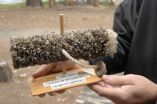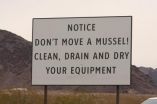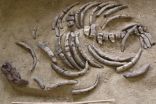(Press-News.org) (Millbrook, NY) Anyone that has spent time at a seaside pier has witnessed the destruction barnacles wreak on boat hulls. But biofouling animals are not limited to marine environments. A new paper published in the journal Frontiers in Ecology and the Environment estimates that the global management of freshwater mussels, clams, and other clinging animals costs $277 million U.S. dollars annually.
Biofoulers are organisms that accumulate underwater on hard surfaces, to the detriment of property and economically important activities, such as shipping, power generation, and water treatment. While plants and algae can act as freshwater biofoulers, the study focused on the impact of animals. Eleven groups known to cause problems were investigated, among them mussels, clams, snails, crustaceans, sponges, and insects.
David Strayer is a freshwater ecologist at the Cary Institute of Ecosystem Studies and one of the paper's authors. "A lot of attention has been given to marine biofouling because it costs a ton of money. Less is known about freshwater impacts. We found most of the economic burden is currently shouldered by utilities. Hydroelectric power plant cooling systems and water treatment intake pipes are particularly vulnerable to damages."
Many freshwater biofoulers are filter-feeders. These animals readily colonize pipes and channel walls, where they collect food from the passing water. Coverage can be extensive. When water treatment intake pipes and filters clog, water flow is obstructed, hastening the corrosion of costly infrastructure. Infestation in hydroelectric power station channels decreases the efficiency of water flow used for power generation.
Management has involved keeping biofoulers out, keeping their numbers low, and killing off infestations. Specialized filters can stop animals from entering facilities that rely on untreated water. To prevent accumulation on hard surfaces, copper alloys, anti-fouling coatings, and ultraviolet light are among the methods used. At water treatment plants and power stations repelling chemicals like chlorine and mechanical cleaning are the most common controls.
Strayer notes, "There are a cornucopia of strategies to combat biofoulers, but most are either costly, or come with the price of polluting water and poisoning non-target organisms."
Given our increasing demand for water and electricity, without action the problem is likely to intensify. First author Daisuke Nakano of Japan's Central Research Institute of Electric Power writes, "Impacts of freshwater biofoulers may soon increase as humans inadvertently move these species around the world, as global demand for freshwater rises, and as human activities favor biofouling species by providing them with suitable habitat."
New water treatment plants and power stations will be susceptible to biofouling. And nutrient pollution and climate change may favor biofoulers. Filter-feeding biofoulers – among the most costly – thrive in the nutrient-rich waters common in developed areas, where they establish on engineered surfaces like concrete walls. Climate warming may increase the range of biofouling animals that are limited by cold temperatures.
In North America, the most troublesome biofoulers include zebra mussels, quagga mussels, Asian clams, and New Zealand mud snails. Strayer notes, "A common theme among these biofoulers is that they are non-native. They are also easily transported on boats and in ballast water. This is a worrisome pattern we are seeing around the world."
Preventing the next global hitchhiker will require vigilance. Strayer stresses that, "Our $277 million dollar estimate is extremely conservative. Right now there is very little research on impacts to freshwater shipping, recreation, and irrigation, or the costs associated with altered freshwater habitat or for biofoulers other than animals. We fully expect the number to rise."
Recommendations include research into understudied freshwater biofoulers, such as sponges and insects, as well as a better understanding of how biofoulers interact with one another, as it is common for multiple species to coexist. Also highlighted is the need for control methods that are both effective and environmentally sensitive, and additional studies on the ecological impacts of biofouler invasions.
When dealing with established biofoulers, improved management is critical. But prevention is the most effective tool. Nakano writes, "At the end of the day, we need education, regulation, and legislation designed to minimize the unintentional global transport of biofouling species."
INFORMATION:
The Cary Institute of Ecosystem Studies is a private, not-for-profit environmental research and education organization in Millbrook, N.Y. For thirty years, Cary Institute scientists have been investigating the complex interactions that govern the natural world. Their objective findings lead to more effective policy decisions and increased environmental literacy. Focal areas include air and water pollution, climate change, invasive species, and the ecological dimensions of infectious disease.
Don't move a mussel (or a clam, or a snail)
Small freshwater biofoulers carry a big price tag
2014-04-02
ELSE PRESS RELEASES FROM THIS DATE:
Beyond proficiency: How early English exposure influences non-native speakers
2014-04-02
PRINCETON, N.J.—Non-native speakers exposed to English before moving to America are more likely to use the language in their daily lives in the United States, according to a report led by Princeton University's Woodrow Wilson School of Public and International Affairs.
Such early exposure – through newspapers, books, TV and classes as well as traveling – may help determine an immigrant's socioeconomic mobility, as English proficiency is strongly tied to cultural and social assimilation. The report, featured in the journal Social Science Research, is one of the first ...
Americans using more energy according to Lawrence Livermore analysis
2014-04-02
Americans used more renewable, fossil and even nuclear energy in 2013, according to the most recent energy flow charts released by Lawrence Livermore National Laboratory.
Each year, the Laboratory releases energy flow charts that illustrate the nation's consumption and use of energy. Overall, Americans used 2.3 quadrillion thermal units more in 2013 than the previous year.
The Laboratory also has released a companion chart illustrating the nation's energy-related carbon dioxide emissions. Americans' carbon dioxide emissions increased to 5,390 million metric tons, ...
Killing a name of an extinct sea cow species
2014-04-02
Sirenians, or sea cows, are a particular group of mammals that superficially resembles whales in having, amongst other features, a streamlined-body and horizontal tail fluke. Though belonging to the so-called marine mammals, such as whales and seals, sea cows are members of a group having a single origin that includes their closest living relatives, the proboscideans (or elephants in the broader sense).
Today, sirenians are known by only four species, but their fossil record is much more diverse documenting the transition from land-dwelling animals to fully aquatic ones. ...
Ethics guidelines for next generation of risky NASA missions
2014-04-02
MEDIA ADVISORY: Institute of Medicine Committee to Report on Ethical Guidelines For Health Standards on Next Generation of NASA Missions: Long Duration and Exploration Spaceflights
WHEN: Embargoed until Wednesday April 2, 2014 11:00 AM EDT
WHAT: Spaceflights beyond low earth orbit or lasting longer than 30 days, including extended stays on the International Space Station and missions to Mars, will likely expose astronauts to increased and even unknown levels of risk, and therefore would not meet NASA's current health standards. The space agency commissioned a report ...
Intelligent warning systems may make 'dilemma zone' safer
2014-04-02
Most drivers have experienced a traffic signal that turns yellow just as they approach an intersection, which makes it difficult for them to decide whether to stop or proceed through it. The wrong choice in this critical situation, known as the "dilemma zone," may lead to crashes, especially at high-speed intersections. A new study published in Human Factors examines how intelligent warning systems help drivers negotiate the dilemma zone and encourage safer driving behavior.
"Intelligent systems could improve driver safety by potentially reducing crashes at signalized ...
Longer stay in hospital ICU has lasting impact on quality of life
2014-04-02
Patients have substantial physical impairments even two years after being discharged from the hospital after a stay in an intensive care unit (ICU), new Johns Hopkins research suggests.
The scientists found that for every day of bed rest in the ICU, muscle strength was between 3 and 11 percent lower over the following months and years.
"Even a single day of bed rest in the ICU has a lasting impact on weakness, which impacts patients' physical functioning and quality of life," says Dale M. Needham, M.D., Ph.D., an associate professor of medicine and of physical medicine ...
Drexel researchers open path to finding rare, polarized metals
2014-04-02
VIDEO:
Researchers in Drexel's College of Engineering have discovered a way to classify and predict the existence of a rare breed of electrically conductive polar metals.
Click here for more information.
PHILADELPHIA - Drexel University researchers are turning some of the basic tenets of chemistry and physics upside down to cut a trail toward the discovery of a new set of materials. They're called "polar metals" and, according to many of the scientific principles that govern the ...
A rainy day can ruin an online restaurant review
2014-04-02
After looking at 1.1 million online reviews for 840,000 restaurants in more than 32,000 cities across the country, Georgia Tech and Yahoo Labs researchers have found that the weather outside can be just as significant a factor for reviews as what happens inside a restaurant. Their study shows evaluations written on rainy or snowy days, or very cold or hot days, are more negative than those written on nice days.
"People love to describe themselves as foodies. But in the end, it looks like we're all weather people, whether we realize it or not," said Saeideh Bakhshi, a ...
Pharmocogenomics has not fulfilled its promise to developing countries
2014-04-02
From 1997 to 2010, despite promises made by the international scientific community, pharmacogenomic research produced few studies focusing on rare, orphan and tropical diseases prevalent in developing countries. Catherine Olivier, bioethics research at the University of Montreal's School of Public Health, recently published these findings in the journal Global Public Health.
Pharmcogenomics is a field of scientific research that studies the interaction between the genomic information of individuals (or populations) and their responses to drugs. In addition to its promising ...
The science of champagne fizz: How many bubbles are in your bubbly?
2014-04-02
The importance of fizz, more technically known as effervescence, in sparkling wines and champagnes is not to be underestimated — it contributes to the complete sensory experience of a glass, or flute, of fine bubbly. A scientist has now closely examined the factors that affect these bubbles, and he has come up with an estimate of just how many are in each glass. The report appears in ACS' The Journal of Physical Chemistry B.
Gérard Liger-Belair notes that effervescence plays an important role in the look, taste, aroma and mouth feel of champagne and other sparkling wines. ...
LAST 30 PRESS RELEASES:
New modeling approach sheds light on rare gut disease
Study documents potentially hazardous flame retardants in firefighter gear
Can certain bacteria regulate aging of the immune system and its related alterations?
AI model helps diagnose often undetected heart disease from simple EKG
There are fewer online trolls than people think
Cell membrane fluctuations produce electricity
Jeonbuk National University study shows positive parenting can protect adolescents against self-harm
Surface-engineered ZnO nanocrystals to tackle perfluoroalkyl substance contamination
This new understanding of T cell receptors may improve cancer immunotherapies
A new fossil face sheds light on early migrations of ancient human ancestor
A new immunotherapy approach could work for many types of cancer
A new way to diagnose deadly lung infections and save lives
40 percent of MRI signals do not correspond to actual brain activity
How brain-inspired algorithms could drive down AI energy costs
Gum disease may be linked to plaque buildup in arteries, higher risk of major CVD events
Contrails are a major driver of aviation’s climate impact
Structure of dopamine-releasing neurons relates to the type of circuits they form for smell-processing
Reducing social isolation protects the brain in later life
Keeping the heart healthy increases longevity even after cancer
Young adults commonly mix cannabis with nicotine and tobacco
Comprehensive review illuminates tau protein's dual nature in brain health, disease, and emerging psychiatric connections
Book prepares K-12 leaders for the next public health crisis
Storms in the Southern Ocean mitigates global warming
Seals on the move: Research reveals key data for offshore development and international ecology
Sports injuries sustained during your period might be more severe
World's first successful 2 Tbit/s free-space optical communication using small optical terminals mountable on satellites and HAPS
Can intimate relationships affect your heart? New study says ‘yes’
Scalable and healable gradient textiles for multi‑scenario radiative cooling via bicomponent blow spinning
Research shows informed traders never let a good climate crisis go to waste
Intelligent XGBoost framework enhances asphalt pavement skid resistance assessment
[Press-News.org] Don't move a mussel (or a clam, or a snail)Small freshwater biofoulers carry a big price tag




